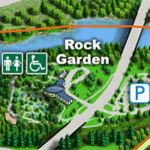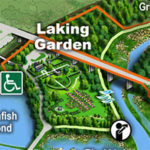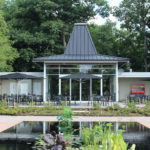| Membership | Price (+HST) |
|---|---|
| Single | $85/year |
| Single Plus | $120/year |
| Family | $130/year |
| Family Plus | $175/year |
| Contributing | $300/year |
| Supporting | $600/year |
| Sustaining | $1,000/year |
| Benefactor's Circle | $2,500/year |
| Director's Circle | $5,000/year |
| President's Circle | $10,000/year |
Smart Water Management in Your Garden
By Jessica Veter, Volunteer, Royal Botanical Gardens.
Have I mentioned before how lazy I am? Why do I bother gardening at all? I’d rather lie in the hammock and look at the garden rather than get up and do anything about it.
So, aren’t I lucky that the water management measures I’ve been implementing are also time/effort saving measures?
Mulch, for example. Not only does organic mulch feed the soil as it breaks down, it shades the soil, helps keep moisture in and helps keep weeds down.
Here are some additional water management tips which equate to more time in the hammock.
Use an irrigation system
They can be small (watering pots on a balcony) or large (for your perennial beds), solar-powered or electric, connected to the mains or a rain barrel. Usually operated by a timer, you don’t have to worry about forgetting to water your plants ever again. Do consider shutting off the system if there’s been a lot of rain. It takes very little effort on our part to preserve this most precious resource.
Rain barrels
Using stored rain water to water your plants is better for your plants and for the environment. Place rain barrels as close as possible to where you need the water.
Plant a rain garden
A rain garden is a depressed area in the landscape that collects water (from a roof, downspout or driveway) and allows it to soak into the ground. Planted with species that don’t mind wet roots, rain gardens can prevent erosion and divert water from storm sewers.
Choose species which use water wisely
Established plants require less water than new plants, so avoid new plantings during the hottest part of summer. Plants with small leaves, or with light-coloured or hairy leaves generally need less water than large-leaved plants. Slow-growing plants are also more conservative with water.
Use grey water
Collect water from the kitchen (either from the washing up or from cooking), fish tank or shower and use that to water your garden. Grey water is not recommended for edible crops.
Water in the morning
This allows water to get to the roots of the plants without losing much of it to evaporation.
Choose appropriate pots and potting soil
Unglazed terra cotta is porous and loses water easily; metal pots can get very hot. A potting mix that holds moisture is best for your containers.
Now if you’ll excuse me, there’s a hammock over there needing lying in.
More from the RBG Blog
Check out RBG’s blog for announcements, articles, and more from Canada’s largest botanical garden.
Want to be sure you hear first? Sign up for our weekly e-newsletter to hear about upcoming events, weekend activities, articles, and more!












